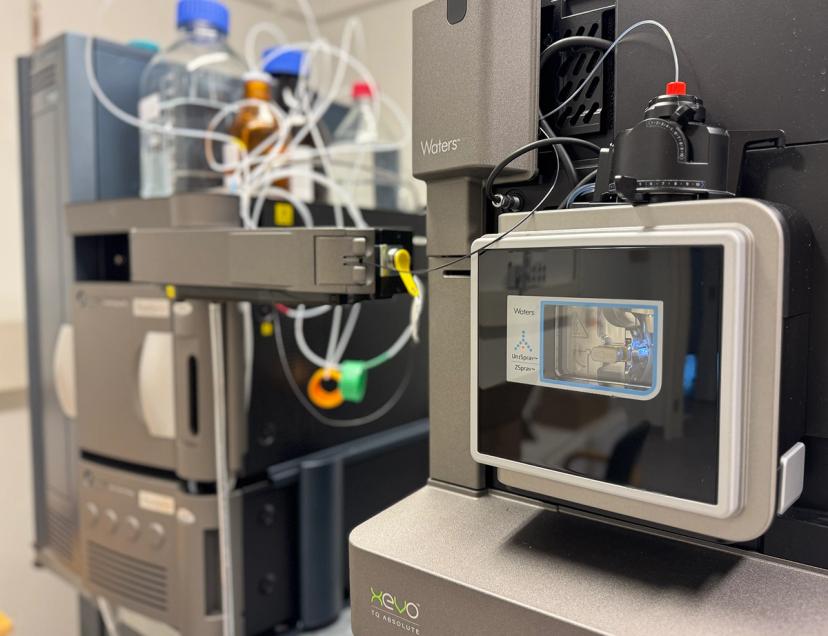Integrating LC-MS and ligand binding assays to meet bioanalytical demands
How two CROs are uniting ligand-binding assays and LC-MS expertise to tackle the complexity of modern biologics
29 Oct 2025
(left) David Pekar, CEO at Lablytica Life Science, (middle) Kristi House, Chief Scientific Officer at Lablytica Life Science, (right) Anna Karaszewska, Product Manager, CRO Services at Svar Life Science
In the race to develop more advanced biologics, like bispecific antibodies, fusion proteins, and ADCs, the ability to generate clear, reliable bioanalytical data is essential. As therapeutics become more complex, no single analytical platform can do it all. The industry is now embracing a more integrated approach, combining ligand-binding assays and liquid chromatography-mass spectrometry to get a fuller, more accurate picture.
Here, in this guest editorial we explore how an emerging collaboration between two expert CROs, Svar Life Science and Lablytica Life Science, is designed to address common bioanalytical challenges and support drug development from discovery through the clinic.
Bridging technologies to meet complexity
Combining LC-MS with ligand-binding assays is reshaping how the industry tackles the demands of increasingly advanced therapeutics. As multifunctional antibodies, fusion proteins, antibody-drug conjugates (ADCs), and other complex biologics continue to evolve, the need for flexible, integrated strategies is growing rapidly.
“By working together, we can provide options for drug developers that are both more practical and efficient. Combining our expertise, we can offer customers very powerful analytical solutions,” shares David Pekar, CEO at Lablytica Life Science.
"We're seeing a shift toward integration, not competition, between technologies," says Anna Karaszewska, Product Manager, CRO Services at Svar Life Science. "It's about combining strengths to match the complexity of modern therapeutics."
When platforms work together, data gets stronger
Selecting the right platform depends on the scientific question and development stage. Ligand-binding assays are often used in GLP-compliant toxicokinetic (TK) studies, anti-drug antibody (ADA) assessments, and neutralizing antibody assays, due to their high sensitivity and throughput.
LC-MS, on the other hand, is used for discovery screening, post-translational modification (PTM) analysis, and studies involving complex biological matrices.
"LC-MS/MS offers extremely specific detection based on a molecule’s retention time, ionization, and mass fragmentation,” explains Kristi House, Chief Scientific Officer at Lablytica Life Science. “This allows for simpler, quicker extraction methods with reduced contamination risk. It’s especially useful when no capture or detection antibodies are available."
Used together, ligand-binding assays and LC-MS provide a complementary data set, essential when working with structurally diverse or novel therapeutics. Measuring drug exposure, confirming identity, identifying degradation products, and evaluating how structural changes may impact therapeutic performance. Additionally, a multi-method bioanalytical approach improves data reliability and strengthens regulatory submissions.
A bioanalytical bottleneck
The challenge is not using LC-MS or ligand-binding assays, it is making them work well together. Ligand-binding assays offer great sensitivity but may struggle to differentiate between active and degraded forms. LC-MS provides structural details but can face limitations in throughput or sensitivity in complex matrices.
Another frequent issue is bandwidth. Many early-stage biotech teams lack the resources to manage both workflows. As programs advance to clinical phases, issues like misaligned timelines, regulatory expectations, and tech transfer issues can create serious bottlenecks.
"Solving these challenges requires early coordination between teams who understand both platforms and can design integrated, fit-for-purpose bioanalytical strategies from the start," says Karaszewska. "It's a strategic decision, not just a technical one."
What integration looks like

"LC-MS/MS offers extremely specific detection based on a molecule’s retention time, ionization, and mass fragmentation,” explains Kristi House, Chief Scientific Officer at Lablytica Life Science
Integration is not just parallel testing. It is a strategy. That means:
- Choosing the right platform for each question
- Aligning development and validation timelines
- Ensuring methods are cross-compatible from the start
- Working with experts who understand both technologies
This is where the collaboration between Svar (ligand-binding experts) and Lablytica (LC-MS specialists) creates real value.
"We're not trying to force-fit a technology," says Karaszewska. "We help clients choose the best-fit strategy for each molecule and then build the workflow around that.”
Svar brings decades of ligand-binding assay expertise, while Lablytica offers deep LC-MS/MS specialization. Together, they offer clients a streamlined strategy tailored to the complexity of the drug, not the limitations of a single tool.
By offering both ligand binding and LC-MS/MS, we give sponsors one contact who can coordinate both strategies," explains Pekar. "They bring us a list of molecules, and we propose the most effective approach for each, while also taking into account the development phase of the project."
Addressing common integration hurdles
The partnership is structured to tackle recurring issues that often disrupt development:
- Strategies that do not match the molecule: Offering tailored, fit-for-purpose methods.
- Uncertainty around regulatory expectations: Building orthogonal methods that satisfy FDA/EMA expectations for robustness and confirmation.
- Fragmented tech transfer: Ensuring method continuity from discovery through clinical stages under the right compliance frameworks (GLP, GCP).
- Resource limitations: Acting as an external team, especially for smaller or growing companies.
A closer look: Tackling a bispecific antibody program
Consider a bispecific antibody program that requires both exposure data and analysis of cleaved fragments that could drive immunogenicity.
"We might start with anti-drug-antibody screening method using LC-MS/MS, thanks to its multiplexing ability for different antibody sub-types, and matrix-independence, says Pekar. "Then we'd follow up with an ligand-binding-assay-based confirmatory assay."
Svar's ligand-binding assays are designed to track total drug access in multiple species. In parallel, Lablytica's LC-MS/MS detects product-related impurities. Together, they deliver both depth and coverage.
"This kind of cross-platform strategy lets us adapt in real time as the molecule evolves," says Karaszewska. "We both share a commitment to scientific rigor and have the flexibility to adapt. It's exciting to see two CROs so engaged in building better outcomes."
The bioanalytical shift: From capability to collaboration
The industry is moving toward coordinated, adaptable partnerships. Collaboration among CROs is essential and equally important as the relationships between sponsors and CROs.
“Our sponsors don’t just want data, they want insight,” says Karaszewska. “They want flexibility and shared accountability. We’re excited to offer something that’s both adaptable and aligned. This isn’t about combining capabilities. It’s about building smarter workflows that deliver better outcomes.”
Five ways LC-MS and liquid-binding assays work better together
- Complementary insights: No single method can fully characterize today's advanced biologics. LC-MS offers structural precision, while ligand-binding assays provide high sensitivity; together, they deliver a complete analytical picture.
- Stronger regulatory packages: Regulators increasingly expect orthogonal methods to confirm key data points like PK, ADA, and comparability. Integrated platforms build confidence and de-risk submissions.
- Smarter, faster decision-making: A dual-platform approach catches early issues (e.g., degradation products, false positives) and supports better molecule selection, faster optimization, and fewer costly re-runs.
- Tailored, fit-for-purpose workflows: Integrated workflows allow scientists to apply the right tool at the right time, whether it is LC-MS for specificity or ligand-binding assays for scalability in clinical studies.
- Improve continuity from discovery to clinic: When LC-MS and ligand-binding assay methods are aligned early, data stays consistent across development stages, reducing rework, simplifying tech transfer, and supporting a smoother regulatory journey.
Bridging analytical gaps is not just about running more tests; it is about designing workflows that deliver better answers. By strategically integrating ligand-binding assays and LC-MS and aligning cross-platform expertise early, drug developers can close the gap between complex molecules and confident decisions. The Svar–Lablytica partnership is built to turn that divide from a hurdle into an advantage.
This guest editorial was authored and submitted by Svar Life Sciences, a contributor to this publication.

